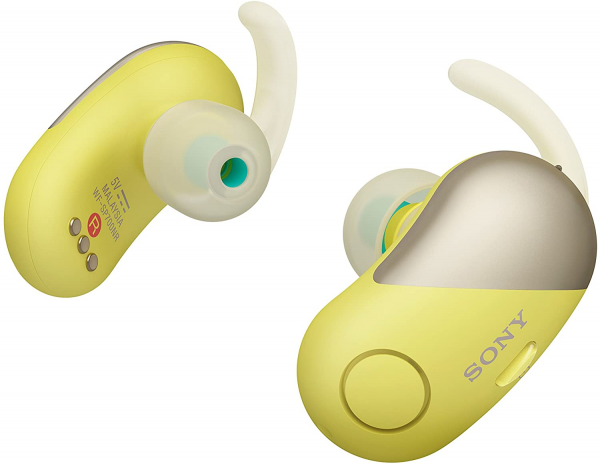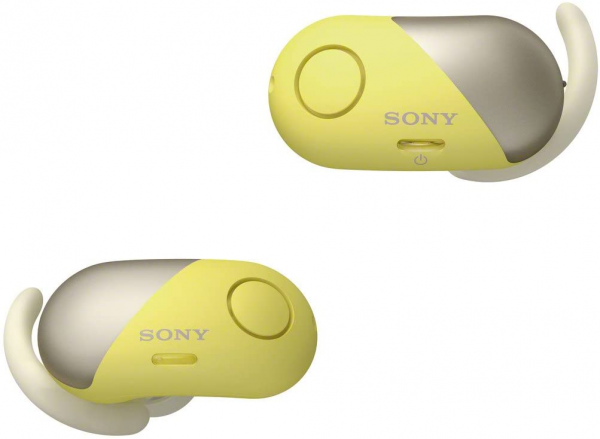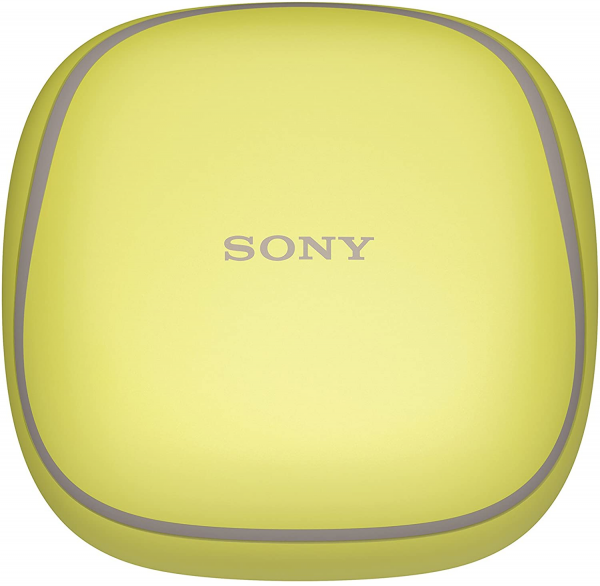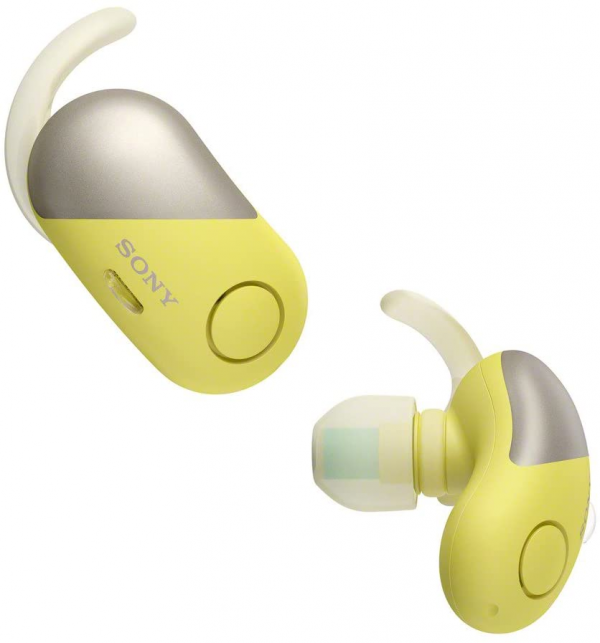Sony
Sports Intras Sony WF-SP700N: Uneven Performance
Aprox. 204€ - see price -
Thanks to their IPX4 certification, their adaptable listening to the outside environment, their excellent support and of course their Extra Bass label, the Sony WF-SP700N promise a 100% wireless and 100% sporty experience.
Our review
Ergonomics
As always, Sony gratifies its intras with an unstoppable lyricism name. The acronym makes sense, however: WF for WireFree, SP for SplashProof and N for Noise (Canceling). And like all good self-respecting true wireless intras, the WF-SP700N snuggles up in a charging case.
This case, usually oblong, is here rather cubic, in grained plastic. Its compactness requires a certain hand to correctly insert the two beans, mainly because of the silicone fins. Take care to "clip" the earphones (red LED), otherwise the recharging will not take place. The box opens by sliding the cover to the side; we then observe a game which, without wanting to play the ominous birds, does not bode well for great robustness. So also take care to systematically close the case after storing or removing the intras.
The battery offers 2.5 hours of autonomy (measured at 75% of maximum volume) with active noise reduction, supplemented by just over two full recharges thanks to the housing. The voice indication announces the battery level when the intras are put on, but unfortunately not when this level is low. So we end up with a "please, headset recharge!" almost superfluous since the second after, it's good night, little ones. A prior warning would therefore not be refused. Note however that the battery level can be viewed from the reader.
Sony supplies four pairs of tips of different sizes, all of which are made of silicone and mono-flanges, as well as two sizes of fins. A bit like the AirPods, despite the impression of average atrial cohesion due to low passive insulation and a featherweight, the support is excellent, even during sports. Protection index X4 ensures resistance to water splashes from all directions, and in particular to perspiration.
We have exceptionally been unable to capture the hands-free kit. Particularly efficient compared to its small true wireless comrades in a quiet environment, it is also usable in noisy environments, provided you are not afraid to give voice. During a call, the sound automatically switches to the left, in mono of course, and the intras broadcast a capture of the sound environment so that the user can not only hear what the other party hears, but also their own voice.
In terms of controls, like many 100% wireless headsets, the WF-SP700N unfortunately does not have volume control or voice assistant activation. The other functions, however, namely play / pause, skip to the next / previous track, Bluetooth pairing, call management and activation of active noise reduction or listening to music. environment, are all accessible via two buttons only, thanks to a set of single / double / triple clicks. If they are very small, the buttons are also particularly protruding, which makes them easily identifiable by touch. As the ear canal is not entirely obstructed, the support required to call on the various controls does not create an overly-unpleasant phenomenon.
We find the Headphones Connect application of which we have spoken many times already, allowing the user to choose between two types of listening to the environment (completely open mode and mode focusing on voices only), to give priority to the sound quality or the stability of the wireless connection, or to use the gyroscope built into the smartphone to automatically detect if the user is on, off, playing sports or in the transport - different types of situations to which the different modes can be assigned. This detection system works well, even a little too well, sometimes making a large number of changes in a very short period of time. Embarrassed, you quickly end up deactivating the function - note however that this functionality depends entirely on the good health of the gyroscope embedded in your smartphone, and that it is a completely optional functionality. The WF-SP700N also benefit from a double click on board the right atrium, allowing you to return to a "default" mode of ambient sound control (ANC On / Off or listening) and to a predetermined equalization.

Audio
The WF-SP700N are stamped Xtra-bass, and for good reason: the extension at the bottom of the spectrum is impressive, and the bass shakes our eardrums. And this, without even boosting the bass via the equalizer ...
The default frequency response therefore offers low solids, fairly clean and dynamic, but far too flattered to be able to remain controlled. Very round, punchy and winding, they take precedence over the rest of the spectrum, and it can even result in a slightly cavernous tone in the low mids, depending on the mix. The overall result, however, avoids the muffled side thanks to the very high frequencies: nicely detailed, they tend to drop slightly on the cymbals without being really aggressive. You will understand: we are in the middle of the signature in W. The uneven and unbalanced side of the frequency response is all the same balanced by a beautiful precision of the membranes, and a musical message which remains understandable. The voices, in particular, are doing surprisingly well, with a good level of intelligibility and respected timbre.
There is a (very) weak crosstalk, which slightly restricts the stereophonic field. Nothing to worry about however: the good level of detail in the treble guarantees in particular a good reproduction of the reverberations and therefore of the acoustic spaces. The power of the earphones is good and largely allows them to create immersive listening, despite the average passive isolation provided by the eartips. Furthermore, the harmonic distortion rate is excellent for Bluetooth in-ear headphones. When you get close to the maximum level, you can however perceive an increase in the distortion - gently sloping, not peaking - around the midrange / low midrange.
Let's move on to active noise reduction, which, like that offered with the WF-1000X, is absolutely anecdotal. We would even challenge any user to determine if it is on or off by putting it on. The transition from passive isolation to active noise reduction when you already have the intras in your ears is more noticeable of course: the background noise located in the first part of the spectrum is then very slightly attenuated, but still comes without pain to our eardrums. What we can say in any case is that it does not risk making you dizzy, and that the sound performance is not in the least impaired by the activation of noise reduction. Listening to the environment is also discreet, but already more convincing: its naturalness makes the option entirely viable when awareness or external vigilance is required.
Like the majority of 100% wireless in-ear, the latency is gigantic. Measured at more than half a second, it therefore not only makes the WF-SP700N unusable for viewing video content, but also sometimes frustrating for simple listening to music (lag between action and result).

Conclusion
Thanks to the resistance, the maintenance, the comfort, the powerful bass, the effective hands-free kit and the natural Ambient Awareness offered by the WF-SP700N, Sony keeps its promises and ensures as advertised a sporty use quite functional. However, the absence of the possibility of adjusting the volume, the application certainly complete but not very sport-oriented, the anecdotal active noise reduction, the autonomy leaving something to be desired and the uneven sound performance prevent them from being set up as gender references .


